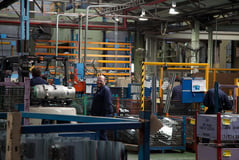The Best Vision for Your Supply Chain
Keith LaBotz - August 26, 2021

7 Ways to Jumpstart Supply Chain Visibility
Ask three people to define supply chain visibility, and you’ll likely get six different answers. Everyone agrees visibility is vital, and it’s a central theme of Logistics 4.0, so how can a supply chain achieve end-to-end visibility without agreement on the definition?
Fortunately, supply chain visibility is more about data access than changing existing processes, so it’s less intrusive. Supply chain partners only need agreement on data access, and that’s getting easier by the day.
 You’ll need buy-in from your organization on planned process improvements, and that’s where a good vision can make all the difference.
You’ll need buy-in from your organization on planned process improvements, and that’s where a good vision can make all the difference.
Let’s look at several steps to help you develop the best possible vision for a supply chain visibility plan and jumpstart its implementation.
-
Define Visibility
The hallmark of good vision is clarity, so it’s no surprise successful process improvements start with clear definitions. By the way, how do you define supply chain visibility?
I define supply chain visibility as awareness. It’s a safe choice - more likely to be struck by lightning before encountering serious disagreement on this definition. Awareness implies actively watching with an intent to respond if needed. Visibility suggests passive observation. Understanding it as awareness shapes my perspective, which is expressed in my opinions, and it affects my analysis of supply chain visibility solutions. If perception is reality, definitions are perception.
Every business determines for itself what’s important, what to monitor in the supply chain, and how it will respond when exceptions are detected. In other words, every business defines supply chain visibility for itself. The reality is most companies face the same challenges and look for the same red flags.
Another way of defining supply visibility is to describe its purpose: to facilitate action that meets the expectations of stakeholders. It’s a little wordy, but I can go with it too. How about you?
Our control over the outcome increases as visibility expands across the supply chain no matter how we define visibility. That’s why end-to-end visibility is the ultimate goal.
While we’re on definitions, here are a few more qualities of visibility to round out this discussion:
- Visibility is a concept: it’s not data, a product feature, or a software category.
- Visibility is a byproduct of properly aligned objectives, processes, and systems.
- If visibility is not actionable, then it’s arguably useless.
- It’s not limited to tracking location, events, exceptions, status, or other notifications.
- There are levels of visibility that address descriptive, predictive, and prescriptive responses. Few companies have gone beyond the descriptive.
-
Define the Data
Data fuels visibility, and without acquiring relevant data, there is no supply chain visibility. You’ll need to find these fuel sources, and a good starting point is surveying information that’s important for achieving objectives. These might include:
- Stakeholder expectations for each shipment.
- Corporate objectives, values, and sustainability goals.
- Operational KPIs and metrics
Once you know where to find the data, you can make plans for acquiring it.
-
Remove Data Silos
 Visibility relies on connecting the dots at every point across a supply chain that begins from inside an enterprise. These connections are a byproduct of aligning the business process (people and systems) with business objectives.
Visibility relies on connecting the dots at every point across a supply chain that begins from inside an enterprise. These connections are a byproduct of aligning the business process (people and systems) with business objectives.
Ensure your enterprise is free of functional and data silos, so no gaps impede end-to-end supply chain visibility. Problem applications should ultimately be corrected or replaced to provide data continuity without any change to workflow.
-
Establish a Platform
What makes a good platform for supply chain visibility? In the previous point, we noted the alignment of business processes and the absence of data silos are ingredients.
Behind every good system design, you’ll find a well-thought-out model: a business, process, and data model supporting each other. A mature data model provides a descriptive snapshot of supply chain logistics processes, clearly linking every component, part, SKU, packaging, shipping containers, and shipments to orders. These relationships are essential for end-to-end transparency.
An enterprise data model that fits this bill can expand to accommodate data elements pertinent to supply processes.
Supply chain solutions for forecasting, planning, routing, monitoring, risk management, transportation optimization can contribute to visibility. These may acquire and process data from across the supply for databases, and they can provide visibility related to the functionality offers. The main issue when introducing such an application is data integrity and preventing the creation of any data silos.
An excellent place to start may be using analytics software to review your company’s structured and unstructured supply chain data. Focusing on transportation and logistics systems can provide much of the framework for monitoring the flow of goods through the supply chain. Shipment level information keyed to tracking numbers, waybill, and pro numbers can also yield valuable insights for linking the chain.
With the right software, you can create a visibility platform using existing systems and expand it as you increase supply chain visibility.
-
Own Your Vision
Supply chain visibility is a strategic asset worth protecting, so maintain ownership of the vision and platform you establish for visibility.
Now for a lesson from supply chain history. Once upon a time, certain companies thought it was safe to entrust every aspect of their business process to all-powerful but highly efficient ERP vendors. The company leaders followed a herd of other leaders and accepted the ERP buzz without question. Many of these companies are into their second decade of trying to free themselves from the giant squid of legacy ERP systems. Meanwhile, competitors are racing ahead of these companies, and the leaders are long gone.
There are multiple lessons from the ERP era, but the point here is to retain control over the vision and platform for supply chain visibility. Change occurs faster now than in the past, and chances are you will see the future and its consequences sooner than expected.
That said, finding good technology vendors, logistics providers, and supply chain partners is significant for making your vision a reality. Look for partners interested in learning about and supporting your vision. A good technology vendor can guide you in defining visibility requirements, implementing relevant solutions, and stay with your business to keep your process evolving with the supply chain.
-
Keep Your Vision Clear
Supply chain visibility is one of those buzzwords where fuzzy buzzy ideas can cloud vision. A vision that’s not grounded in reality (constraints), misunderstood, or poorly communicated can result in poorly defined objectives and specifications. Poor visibility doesn’t just take down supply chains, it’s also a leading cause for project failures, and it’s one of the more manageable risks to eliminate.
 Focusing on stakeholder expectations and evidence-based claims will keep your vision sharp and plan on track. Investing time to think about the supreme idea supply chain can also improve your focus and generate insights.
Focusing on stakeholder expectations and evidence-based claims will keep your vision sharp and plan on track. Investing time to think about the supreme idea supply chain can also improve your focus and generate insights.
-
Share Your Vision
Supply chain visibility requires collaboration, so you’ll need to provide partners with clearly defined requirements you can collaborate on. If you have a clear vision of what you need, sharing it with partners will be easier.
Summary
Gaining support for greater visibility is not difficult if you follow the steps outlined. The outcome of any project depends on the clarity of the vision and plan. The challenge will be implementing with supply chain partners, and that’s a can of worms we’ll open in another post.
I hope this post is helpful, and feel free to share your thoughts.
For more information about Supply Chain visibility, click the image below.
LATEST POSTS
- Understand Why Production Planning Needs Specialized Solutions
- Understand Circular Economy in The Manufacturing Industry
- How Can Industry 4.0 IT Integration Be Achieved Smoothly?
- The Significance of Order Sequencing in Discrete Manufacturing
- How to improve your Supply Chain Management: The Power of Control Towers



